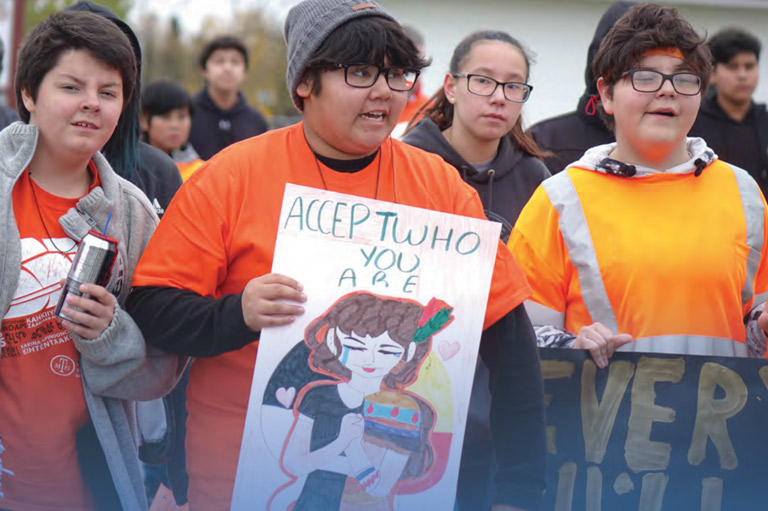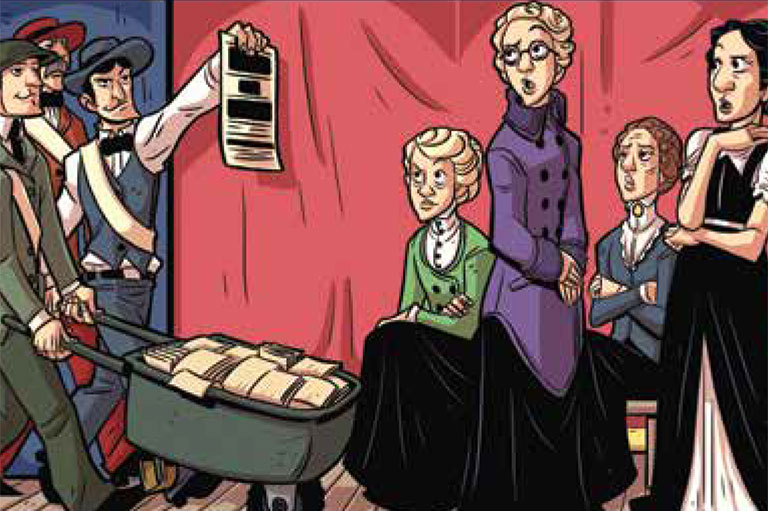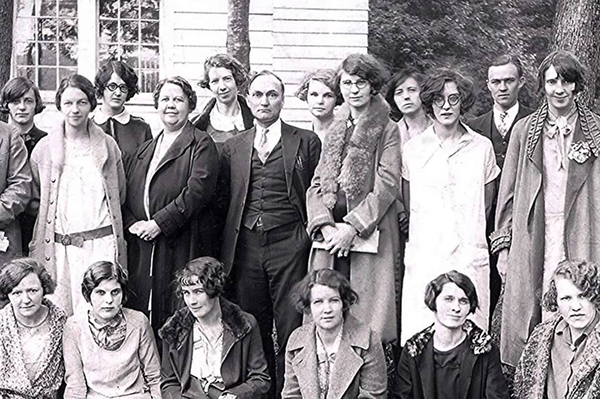Discover a wealth of interesting, entertaining and informative stories in each issue, delivered to you six times per year.
First Nations Diary: Documenting Daily Life
Grade Levels: 7/8
Subject Area: Social Studies, History, First Nations, Métis, and Inuit studies, Geography, Language Arts, Visual Arts
Lesson Overview
Students learn how Indigenous peoples were impacted by settlement and colonization. Students choose a variety of Indigenous nations and learn aspects of their traditional way of life before settlement/colonization by Europeans.
Note: An Indigenous guest (Elder, teacher, historian, activist) invited to participate in this set of lessons would add authenticity and relevance to the material.
Time Required
5 double-periods (1:40 x 5)
Historical Thinking Concept(s)
This lesson plan uses all six historical thinking concepts. This includes: establish historical significance, use primary source evidence, identify continuity and change, analyze cause and consequence, take historical perspectives, and understand the ethical dimension of historical interpretations.
Learning Outcomes
Students will:
- Demonstrate their understanding of a chosen number of Indigenous nations’ way of life before contact with Europeans
- Utilize research tools and collect information that they will organized into notes
- Develop effective note-taking strategies
- Explain what they’ve gleaned in their note-taking and share it with other students
- Demonstrate their skills in using graphic organizers
- Synthesize knowledge obtained through discussion, research and note-taking
- Create a detailed journal/diary that depicts pre-contact ways of life of Indigenous peoples.
- Create a journal entry that depicts present-day ways of life in Canada and compare it to an Indigenous nation’s pre-contact way of life.
- Hone their writing skills.
- Demonstrate their allyship with First Nations kids today who suffer systemic injustices.
Background Information
When Europeans colonized Canada they encountered a multitude of Indigenous nations. Students will review several nations of Indigenous peoples and research how they they organized themselves to meet their needs (physical, emotional, spiritual, and cognitive). This lesson plan incorporates the use of technology for living their daily lives. An Indigenous guest speaker from the nation of whose tools are being studied should be invited to the class to provide the context and meaning of the technologies, also providing information that students will need to understand how Indigenous peoples’ emotional, spiritual, and cognitive needs were met as well as just their physical needs.
The Lesson Activities
Activating:
Always begin the class with an acknowledgement of whose Indigenous territory the school is on and thank them. Students will be preparing for learning by consulting a North American maps of Indigenous nations. Teacher should create questions for students to answer based on content beginning with a KWL chart. View the National Film Board of Canada’s For Angela as an opening to a discussion of racism in Canada today. Have students take notes as they watch For Angela as they will need them to do a comparative assignment.
Acquiring:
The lessons should all begin by having students reflect on the question, “What does an ideal society look like?” Students may list these qualities in their notebooks or they may be written on post-its that will be prominently displayed somewhere in the classroom.
Individually or in groups
- Students label the location of Indigenous groups on a map of North America as defined by the use of their technologies for living their daily lives. They may use a map that uses Indigenous people’s names for themselves in their own language, or they may use an English language map.
- For example:
- Corn Planters: Southern Lakes area and St. Lawrence River Valley
- Potlatch People: The Pacific shores of Canada and the United States from Alaska to Washington to Oregon
- Buffalo Hunters: Area between the Mississippi and Rocky Mountains in the United States and the southern part of Canada from the Rocky Mountains in Alberta to the Manitoba border.
- For example:
- Use chart format and text to teach note-taking. Complete Corn Planters as a sample with whole class and and then individual students complete chart notes for Buffalo Hunters and Potlatch People while focussing on the question, “How did Indigenous peoples meet their physical, social and group needs?” or if the teacher wants to follow a circular format, the question can be posed “How did Indigenous peoples meet their physical, emotional, spiritual, and cognitive (mind) needs?” Notes are evaluated on the use of students’ own words, accuracy, and thoroughness. A couple of suggested formats for answering the question could be:
- Suggestion 1: Corn Planters (i.e. Iroquois/Huron)
- Physical
- Food:
- Clothing:
- Shelter:
- Social
- Education
- Social
- Family
- Group Cultural
- Religion
- Government
- Economy/Trade
- Physical
- Suggestion 2: Corn Planters (i.e. Haudenosaune/Wendat)
- Physical
- Food: corn, beans, squash
- Clothing: leather, furs
- Shelter: Longhouses
- Emotional
- Family: clan member
- Art
- Games
- Spiritual
- Maple ceremony
- Planting ceremony
- Strawberry ceremony
- Cognitive (mind)
- Government
- Education system
- Medical system
- Physical
- Suggestion 1: Corn Planters (i.e. Iroquois/Huron)
- Using resources in small groups, complete detailed notes on Buffalo Hunters, Potlatch People, or Corn Planters. Students become experts on a concept such as “physical needs” and then presents it to the group.
Applying:
- With students sitting in a circle, discuss the qualities an ideal society should have. Ascertain how each of the groups meets these qualities. Elicit student volunteers to record ideas the group brings up.
- To encourage deeper thought and reflection students are encouraged to complete either:
- a Venn Diagram that compares two of the Indigenous groups studied, or
- use a program like “Inspiration” to web the physical, social, and political needs of one of the groups studied.
- Complete DIARY/JOURNAL assignment - Appendix 1
- To encourage even deeper critical thought and reflection concerning present-day circumstances of Indigenous peoples in Canada and their non-Indigenous neighbours, complete either a Venn Diagram that compares the situation of Indigenous peoples today as witnessed in For Angela present-day culture of Canadian society.
- Complete DIARY/JOURNAL assignment - Appendix 1
Materials/Resources
- First Nation Profiles Interactive Map
- Map of Canada: Indigenous communities and tribal councils
- Map of Canada: Aboriginal First Nations in their own names and locations
- KWL chart
- National Film Board of Canada: For Angela by Nancy Trites Botkin & Daniel Prouty
- Map of Indigenous groups of North America
- “Inspiration” software
- National Film Board of Canada: We Can’t Make the Same Mistake Twice (Alanis Obamsawin covers 9 years of hearings and testimony on the historic law suit against the Government of Canada for discriminating against First Nations Children in all aspects of their lives.
- First Nations Child and Family Caring Society
- 7 ways you can make a difference
- Appendix 1
- Appendix 1b
- K-W-L Chart Rubric
Extension Activity
This is a social justice activity that positions all students as allies of First Nations children in their struggle for justice. In light of the Truth and Reconciliation Commissions “Calls to Action”, this extension activity highlights the 6th Historical Thinking Concept of “understanding the ethical dimension.” Students will not only understand it, but will “live it” thereby making history.
To prepare for this, an Indigenous guest speaker can be invited to talk about the Human Rights Complaint. Prepare students by getting them to research a social justice issue in Canada, for example the outstanding discrimination complaint filed by the First Nations Child and Family Caring Society FNCFCS) and the Assembly of First Nations (AFN) concerning the lack of equitable funding of First Nations children in health, child welfare, and education. Students can then enact a social justice action to demonstrate their support of Indigenous youth in struggles for equity. See resources for support materials.





